Pretty much any cult movie addict who’s been delving into the vast world of psychotronic cinema (and is functionally literate) has a bookshelf or two that represents their filmic tastes as much as their overflowing racks of VHS tapes and DVDs. It’s not that surprising, as despite how much information ends up on the internet, there’s no substitute for a physical tome on your lap to flip through, filled with information about oddball flicks, interviews with noteworthy actors and directors, and full-color reproductions of some of the most garish posters in film history.
With that in mind, the brain trust at Daily Grindhouse (G, Jonny A-Bomb, Sweetback and P) have put their bibliophilia to the test and come up with 50 Cult Movie Books Every Fan Should Have. Many of these may already adorn your shelves, but all of them serve as invaluable (and often entertaining) reference works that, together, make for a library any cult movie fan should be proud of.
Couple of quick notes:
– These are not ranked in order of best to last, worst to best, or Guttenberg to De Niro. This is just a collection of books you may want to take a look at. Below are titles 50-41, and we’ll be rolling out ten titles every day this week.
– Click the cover of the books to buy the goods, all the cool kids are doing it.
50. Mario Bava: All the Colors of the Dark (2007)
by Tim Lucas
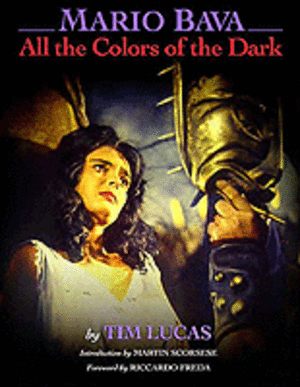 An epic, obsessively researched history of Mario Bava’s life and career pieced together over 32 years, Tim Lucas’ “All The Colors of the Dark” might very well be, as Quentin Tarantino declared it, “the best book on films ever written”. Impeccably structured, with each of the director’s many films deconstructed and relayed in detail, Lucas packs the book with color posters and photos and enough detail to overwhelm even the most ardent fan of Italian horror cinema. A must-own masterwork of cinematic obsession. – D
An epic, obsessively researched history of Mario Bava’s life and career pieced together over 32 years, Tim Lucas’ “All The Colors of the Dark” might very well be, as Quentin Tarantino declared it, “the best book on films ever written”. Impeccably structured, with each of the director’s many films deconstructed and relayed in detail, Lucas packs the book with color posters and photos and enough detail to overwhelm even the most ardent fan of Italian horror cinema. A must-own masterwork of cinematic obsession. – D
For Further Reading: Troy Howarth’s “The Haunted World of Mario Bava” is a worthy look at the grandmaster of Italian horror itself, even if it lacks the scope of Lucas’s tome.
49. The Big Lebowski: The Making of a Coen Brothers Film (1998)
by Tricia Cooke/ William Preston Robertson
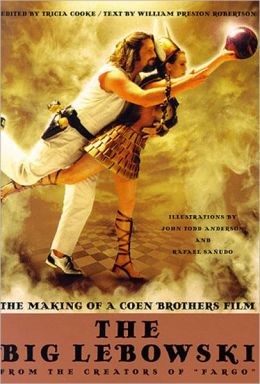 As the premier trickster-auteurs of American movies, the Coen brothers are notoriously opaque interviewees. It’s not common to get a straight answer out of them, though it’s gotten a bit moreso over the last few years. The Coens have rarely been so transparent about their process as they are in this book, written by William Preston Robertson (a longtime friend) and Tricia Cooke (who is both an editor on many Coen films, alongside the legendary Roderick Jaynes, and also Ethan’s wife). There is no Coen brothers commentary on any of THE BIG LEBOWSKI DVDs, but there is this book. One of many interesting aspects is the focus on the Coens’ longtime storyboard artist, J. Todd Anderson, who is described as a major collaborator in the envisioning of the look of the films. Since the Coens so often work with world-class cinematographers, including the brilliant Roger Deakins in this case, I’m not sure how much of the exaltation of J. Todd Anderson is a put-on. It’s probably the case that he is as valuable a player as this book claims, but there’s a chance it might not be. I can’t say for sure. I’d like to take another look but the book disappeared while I was working on this article. – J
As the premier trickster-auteurs of American movies, the Coen brothers are notoriously opaque interviewees. It’s not common to get a straight answer out of them, though it’s gotten a bit moreso over the last few years. The Coens have rarely been so transparent about their process as they are in this book, written by William Preston Robertson (a longtime friend) and Tricia Cooke (who is both an editor on many Coen films, alongside the legendary Roderick Jaynes, and also Ethan’s wife). There is no Coen brothers commentary on any of THE BIG LEBOWSKI DVDs, but there is this book. One of many interesting aspects is the focus on the Coens’ longtime storyboard artist, J. Todd Anderson, who is described as a major collaborator in the envisioning of the look of the films. Since the Coens so often work with world-class cinematographers, including the brilliant Roger Deakins in this case, I’m not sure how much of the exaltation of J. Todd Anderson is a put-on. It’s probably the case that he is as valuable a player as this book claims, but there’s a chance it might not be. I can’t say for sure. I’d like to take another look but the book disappeared while I was working on this article. – J
48. Japan’s Favorite Mon-Star: The Unauthorized Biography of “The Big G” (1999)
by Steve Ryfle
In his debut film GOJIRA, Godzilla is a mean relic of the past; walking through the symbolism of World War II to lay waste on Tokyo. Tossing trains aside like the smallest bugs, wandering through power lines, and with each step he gained more and more fans. He is an icon who quickly created a franchise and a genre of films that continue to inspire today (look no further than PACIFIC RIM for your latest hit of fan-boy cool). Though all 22 films (and the 1998 remake) are covered and analyzed, it is the behind-the-scenes stories and interviews which set this book apart. Author Steve Ryfle understands the impact of the character, he is clearly a fan, but he pays particular attention to the production of these films. Critics were always quick to dismiss these films. The people behind the productions went unnoticed, particularly here in the states, but Ryfle changed all that with this book and spent as much time on the monster as he did on those that created him. You will not find a better book on the big fella. – G
47. Night of the Living Dead: Behind the Scenes of the Most Terrifying Zombie Movie Ever (2010)
by Joe Kane
You could fill a library with books about the making of NIGHT OF THE LIVING DEAD, but you could fill the glove box in your car with the good ones, and this one is the best there is. Joe Kane is better known as The Phantom of the Movies and Editor-in-Chief of Videoscope. He has been around the cinematic block; perfected his ass-groove in theater seats through the good and the bad. Bottom line: he has an incredible amount of film knowledge which lends itself to being able to completely deconstruct a classic film while providing a comprehensive look at what went in to making a film that changed the face of horror. Kane goes behind the scenes of all the official Dead films and provides a thoughtful look at the legacy George Romero created (including the ripoffs, and remakes that the series spawned). (Spoiler: Aim for the head.) – G
For further reading: Though long out of print, The Zombies That Ate Pittsburgh is a great profile of Romero’s films, even if the publication date of 1987 dates it a bit, and just mentions his output up to “Tales from the Darkside.”
46. Conversations with Clint: Paul Nelson’s Lost Interviews with Clint Eastwood, 1979-1983 (2011)
Edited by Kevin Avery
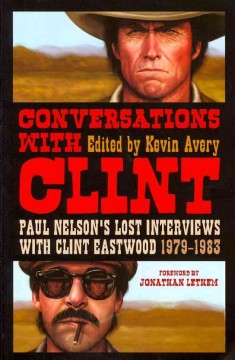 Clint Eastwood has been famous forever, but in a weird way we probably know more about any one of those stupid celebrities who got famous on a reality show last year than this great American artist who has made five decades’ worth of movies. Clint is not exactly the most forthcoming human being who ever lived. He’s given plenty of interviews over the years, but even those are fairly guarded and civil. In these recently unearthed interviews with a Rolling Stone reporter who appreciated his work long before the critical consensus had much nice to say, Clint holds forth with more candor than usual. Clint talks about his early days, the business side of filmmaking, his critics, mistakes he made, actors and movies he respects, the memorable roles he turned down, and projects he was working on (some of which never happened). Paul Nelson, who emerges as an interesting, opinionated figure in his own right, is a far more informed interviewer than most, and Clint returns the favor with a volley of memorable quotes. Also, this series of lengthy conversations features an extended cameo by Warren Zevon, a friend of Paul Nelson whom you may know as a singer and songwriter. – J
Clint Eastwood has been famous forever, but in a weird way we probably know more about any one of those stupid celebrities who got famous on a reality show last year than this great American artist who has made five decades’ worth of movies. Clint is not exactly the most forthcoming human being who ever lived. He’s given plenty of interviews over the years, but even those are fairly guarded and civil. In these recently unearthed interviews with a Rolling Stone reporter who appreciated his work long before the critical consensus had much nice to say, Clint holds forth with more candor than usual. Clint talks about his early days, the business side of filmmaking, his critics, mistakes he made, actors and movies he respects, the memorable roles he turned down, and projects he was working on (some of which never happened). Paul Nelson, who emerges as an interesting, opinionated figure in his own right, is a far more informed interviewer than most, and Clint returns the favor with a volley of memorable quotes. Also, this series of lengthy conversations features an extended cameo by Warren Zevon, a friend of Paul Nelson whom you may know as a singer and songwriter. – J
45. If Chins Could Kill: Confessions of a B-Movie Actor (2002)
by Bruce Campbell
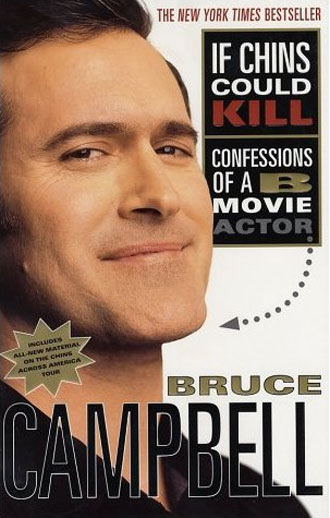 Hard to believe it’s been more than a decade since Evil Dead actor and cult legend Bruce Campbell released this frank and entertaining autobiography. While his career never quite took off the way most dedicated fans would have hoped, Campbell has established himself as a reliable journeyman character actor and always entertaining (and smarmy) presence on television and in films. But this was one of the first steps to establishing the Bruce Campbell persona as a bigger brand, that would soon lead to Campbell-specific parts in Old Spice commercials and – notably – in MY NAME IS BRUCE (where the actor plays a jerk-off version of himself). Still a brisk, entertaining read.. and proof that the actor’s trademark voice transfers quite capably to the written word. – D
Hard to believe it’s been more than a decade since Evil Dead actor and cult legend Bruce Campbell released this frank and entertaining autobiography. While his career never quite took off the way most dedicated fans would have hoped, Campbell has established himself as a reliable journeyman character actor and always entertaining (and smarmy) presence on television and in films. But this was one of the first steps to establishing the Bruce Campbell persona as a bigger brand, that would soon lead to Campbell-specific parts in Old Spice commercials and – notably – in MY NAME IS BRUCE (where the actor plays a jerk-off version of himself). Still a brisk, entertaining read.. and proof that the actor’s trademark voice transfers quite capably to the written word. – D
For further reading: Campbell’s follow-up, “Make Love! The Bruce Campbell Way” is a work of fiction starring Campbell as a lead character and is just as fun, and the whole EVIL DEAD franchise (save for the remake) is well-chronicled in Bill Warren’s “The Evil Dead Companion.”
44. That’s Blaxploitation!: Roots of the Baadasssss ‘Tude (1995)
by Darius James
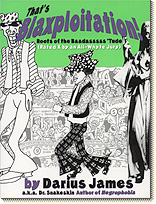 There’s certainly room for a definitive guide to every film that would classify as “Blaxploitation.” The slender volume by Darius James, author of the cult fave NEGROPHOBIA, is not that guide. The reviews are brief (CLAUDINE’s is simply, “Diahann Carrroll on welfare. Right.”), distracted (the synopsis for SCREAM, BLACULA, SCREAM consists entirely of a concept for a third film) and outright flippant (About HIT MAN: “It’s on video. You watch it.”), so anyone looking for a valuable “reference work” is just going to have to take a pass. (James Robert Parish and George H. Hill’s recently reissued “Black Action Films” makes for a more traditional guide.) What the book has instead is pure, anarchic attitude. Amidst the divided and hilarious reviews, there’s interviews with the likes of Antonio Fargas, Pam Grier, Iceberg Slim, Ralph Bakshi and two members of The Last Poets. There’s a guide to the pimp. An examination of SHAFT in the form of a treatment for SHAFT AMONG THE JEWS.. AGAIN. And a corner flip-animation from Rick Trembles recreating the climactic scene from WELCOME HOME, BROTHER CHARLES. There isn’t a single page of THAT’S BLAXPLOITATION that isn’t both entertaining and informative, and even if it’s far from a definitive guide, I wouldn’t have it any other way. – P
There’s certainly room for a definitive guide to every film that would classify as “Blaxploitation.” The slender volume by Darius James, author of the cult fave NEGROPHOBIA, is not that guide. The reviews are brief (CLAUDINE’s is simply, “Diahann Carrroll on welfare. Right.”), distracted (the synopsis for SCREAM, BLACULA, SCREAM consists entirely of a concept for a third film) and outright flippant (About HIT MAN: “It’s on video. You watch it.”), so anyone looking for a valuable “reference work” is just going to have to take a pass. (James Robert Parish and George H. Hill’s recently reissued “Black Action Films” makes for a more traditional guide.) What the book has instead is pure, anarchic attitude. Amidst the divided and hilarious reviews, there’s interviews with the likes of Antonio Fargas, Pam Grier, Iceberg Slim, Ralph Bakshi and two members of The Last Poets. There’s a guide to the pimp. An examination of SHAFT in the form of a treatment for SHAFT AMONG THE JEWS.. AGAIN. And a corner flip-animation from Rick Trembles recreating the climactic scene from WELCOME HOME, BROTHER CHARLES. There isn’t a single page of THAT’S BLAXPLOITATION that isn’t both entertaining and informative, and even if it’s far from a definitive guide, I wouldn’t have it any other way. – P
For further reading: The entertaining “What It Is… What It Was” also features some great interviews, and Josiah Howard’s “Blaxploitation Cinema: An Essential Reference Guide” lives up to its name. But you can’t beat the writer of the cult magazine BadAzz Mofo, David Walker, when it comes to the subject, and many of his writings from the mag are reprinted in “BadAzz MoFo’s Book of Blaxploitation.”
43. Bronson’s Loose!: The Making of the Death Wish Films (2006)
by Paul Talbot
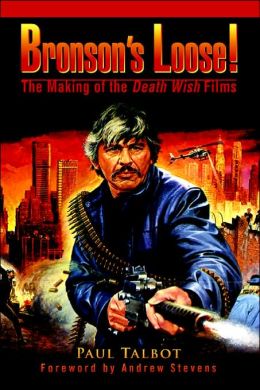 If you disregard the indexes and appendixes, Paul Talbot’s book clocks in at a sleek 117 pages, easily the shortest tome of this list. However, when you consider that it’s only about the making of five films, that’s not a bad ratio, and those 117 pages are filled with enough thoroughly-researched material to keep the most determined action fan glued to the edge of their proverbial seat. Reading about the conception of the five films in the DEATH WISH franchise gives a fascinating look at the changing face of the exploitation movie industry. Jumping from major studio release in 1974 to the Cannon-produced sequels that practically defined the ‘80s to the last gasp of 1994’s barely-released DEATH WISH V: THE FACE OF DEATH, Talbot’s willingness to delve into every aspect of the films – from conception to production to distribution – paints a picture that no self-respecting grindhouse fan should pass by. And what better a spirit guide to have throughout the journey than Charles Bronson, who, despite being the only constant in all five films, remains just as enigmatic as you’d expect him to be. – P
If you disregard the indexes and appendixes, Paul Talbot’s book clocks in at a sleek 117 pages, easily the shortest tome of this list. However, when you consider that it’s only about the making of five films, that’s not a bad ratio, and those 117 pages are filled with enough thoroughly-researched material to keep the most determined action fan glued to the edge of their proverbial seat. Reading about the conception of the five films in the DEATH WISH franchise gives a fascinating look at the changing face of the exploitation movie industry. Jumping from major studio release in 1974 to the Cannon-produced sequels that practically defined the ‘80s to the last gasp of 1994’s barely-released DEATH WISH V: THE FACE OF DEATH, Talbot’s willingness to delve into every aspect of the films – from conception to production to distribution – paints a picture that no self-respecting grindhouse fan should pass by. And what better a spirit guide to have throughout the journey than Charles Bronson, who, despite being the only constant in all five films, remains just as enigmatic as you’d expect him to be. – P
For further reading: The amazing coffee table book “Crystal Lake Memories: The Complete History of Friday the 13th” gives similar treatment to the slasher film franchise, giving it the oral history treatment it deserves.
42. A Hundred Years of Japanese Film (2002)
by Donald Ritchie
He considered himself only a writer, but the late Donald Ritchie was more than that. He was an ambassador to Japanese Cinema. My journey to the films of the region began with Akira Kurisawa which then lead me to Hideo Gosha and Kenji Fukssaku. I had a particular idea of what to expect from Japanese films but Ritchie quickly introduced me to directors I had never heard of, films that I had never seen. Ritchie has an authoritative style but a welcoming approach which doesn’t require previous exposure to artists discussed. He doesn’t really review individual films as much as he comments on the themes, cycles in Japanese cinema, and analyzes individual studios (though unfortunately Nikkatsu, and Toei get short changed) all through the lens of history while occasionally dipping into the peripheral events affecting the region. Ritchie was passionate about film, but even more passionate about Japan (he eventually called it home) and it comes through on every page. – G
41. “Hell Through A Windshield” found in The Best of Joe R. Lansdale (2010)
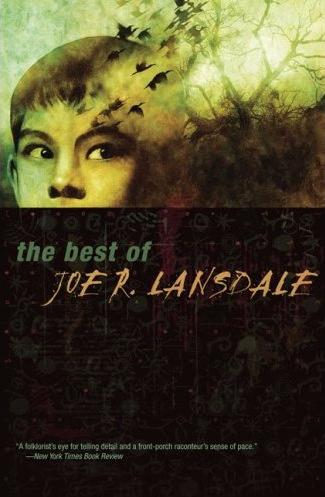 Joe R. Lansdale is a novelist and a short story writer. He’s also done plenty of comic books and screenplays. He’s my favorite writer, visceral and hysterical, the one whose work I will read no matter what medium it arrives in. He does not, however, write much in the way of film criticism or non-fiction. This short piece is a rare exception, and it finds him talking about the drive-in movie experience, which was a huge part of the allure for him, Texas-born-and-bred, and eventually led to his wild and spooky horror novel THE DRIVE-IN. Sadly the drive-in has only ever been the realm of myth to a New York kid like me, but I love the way Joe Lansdale writes about it. He also finds room in this piece for a tip of the hat to Joe Bob Briggs, another local figure whose cult-film talk-ups reached me all the way northeast during formative years. I am indebted to both of these Texas Joes, and my guess is that many Daily Grindhouse readers feel the same way. If you aren’t doing it already, read everything Joe R. Lansdale writes. Tips for a happier, healthier, more inspired life. – J
Joe R. Lansdale is a novelist and a short story writer. He’s also done plenty of comic books and screenplays. He’s my favorite writer, visceral and hysterical, the one whose work I will read no matter what medium it arrives in. He does not, however, write much in the way of film criticism or non-fiction. This short piece is a rare exception, and it finds him talking about the drive-in movie experience, which was a huge part of the allure for him, Texas-born-and-bred, and eventually led to his wild and spooky horror novel THE DRIVE-IN. Sadly the drive-in has only ever been the realm of myth to a New York kid like me, but I love the way Joe Lansdale writes about it. He also finds room in this piece for a tip of the hat to Joe Bob Briggs, another local figure whose cult-film talk-ups reached me all the way northeast during formative years. I am indebted to both of these Texas Joes, and my guess is that many Daily Grindhouse readers feel the same way. If you aren’t doing it already, read everything Joe R. Lansdale writes. Tips for a happier, healthier, more inspired life. – J
Click here for Part 2: Picks 40-31
SEE YOU ON FORTY DEUCE,
DAILY GRINDHOUSE
FOLLOW US ON TWITTER @DAILYGRINDHOUSE
- [THE BIG QUESTION] WHAT’S YOUR FAVORITE FEMALE ENSEMBLE IN MOVIES? - July 22, 2016
- [IN THEATERS NOW] THE BOY (2016) - January 24, 2016
- Cult Movie Mania Releases Lucio Fulci Limited Edition VHS Sets - January 5, 2016

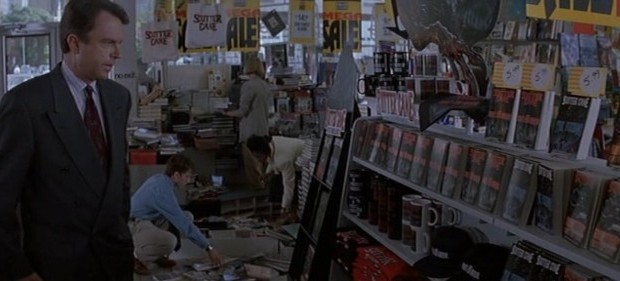
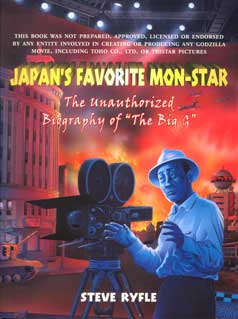

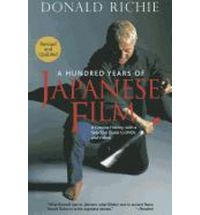




No Comments